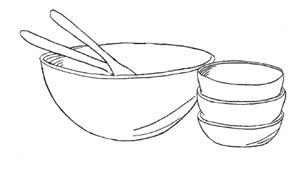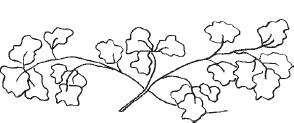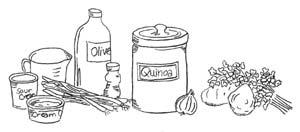Nourishing Traditions: The Cookbook That Challenges Politically Correct Nutrition and The... (131 page)
Authors: Sally Fallon,Pat Connolly,Phd. Mary G. Enig
Tags: #Non-Fiction, #Reference, #Science, #Health
ALGERIAN WEDDING RICE
Serves 6-8
3 cups
basic brown rice1 cup dried apricots, cut into bits, soaked in filtered water about 1 hour and drained
½ cup crispy almond slivers (
Crispy Almonds
), toasted½ cup
crispy pine nuts2 bunches green onions, chopped
4 tablespoons butter, softened
sea salt and pepper
Toss the cooked rice with remaining ingredients. Season to taste. Place in a buttered casserole and bake at 250 degrees for about 30 minutes.
RAINBOW RICE SALAD
Serves 8
4 cups
basic brown rice1 red pepper, seeded and diced
1 green pepper, seeded and diced
1 bunch green onions, chopped
1 cup fresh pineapple, cut into small pieces
½ cup raisins
1 cup
basic dressing
Mix all ingredients together. May be pressed into a mold and inverted for serving.
Perhaps one of the most remarkable aspects of the saturated fat issue is that the
trans
fatty acids were kept out of both government and private food composition data bases for several decades!
Trans
fatty acids were treated as a nonissue by most technical and government information sources and by the media for several decades, though that situation has now changed. The Harvard University School of Public Health has established a data base that includes the
trans
fatty acids for a large number of foods; at least one of the commercial food analysis programs has begun the inclusion of
trans
fatty acids in its data base; it was only in the mid 1990s that the U.S. Department of Agriculture's provisional table of
trans
fatty acids in foods surfaced. Mary G. Enig, PhD
Know Your Fats

ORIENTAL RICE SALAD
Serves 8
4 cups
basic brown rice1 bunch green onions, chopped
½ cup
Crispy Cashews
, chopped1 small can water chestnuts, drained and sliced
1 cup
Oriental dressing
Mix all ingredients together and let stand an hour or so before serving.
Know Your Ingredients
Name This Product #28
Enriched parboiled long grain rice (preserved with BHT), wild rice, hydrolyzed vegetable protein, monosodium glutamate, dried onion, salt, dextrose, beef extract, dried torula yeast, dried parsley, dried celery, dried garlic, partially hydrogenated vegetable oil, natural flavors, artificial flavor.
See
Appendix B
for Answer
WILD RICE
Serves 6-8
2 cups wild rice
4 cups warm filtered water plus 4 tablespoons
whey
,
yoghurt
,
kefir
or
buttermilk1 teaspoon sea salt
2-4 tablespoons butter
Place wild rice and warm water mixture in a flameproof casserole and leave in a warm place for at least 7 hours. Bring to a boil, skim, reduce heat, stir in salt and butter and cover tightly. Without removing lid, cook over lowest possible heat for about 45 minutes.
Not technically a cereal grain, but the seed of a marsh-growing plant native to North America, wild rice was harvested by the North American Indians and formed an important part of their diet.
Wild rice is rich in protein, containing more lysine and methionine than most other cereals. It is high in B complex vitamins and rich in minerals including magnesium, potassium, phosphorus and zinc. Wild rice is relatively low in fat, so eat it with plenty of butter—or bear or beaver grease if you have them on hand! SWF

WILD RICE CASSEROLE
Serves 6-8
2 cups cooked wild rice
½ cup melted butter
1 bunch green onions, chopped
grated rind of 2 oranges
½ cup slivered crispy almond slivers (
Crispy Almonds
) or
crispy pine nuts¼ cup parsley, finely chopped or ½ cup cilantro, coarsely chopped
Mix cooked rice with remaining ingredients. Place in a buttered casserole and bake at 250 degrees for about 30 minutes.
Variation: Wehini Rice Casserole
Use
2 cups
basic wehini rice
instead of cooked wild rice.
Variation: Texmati Rice Casserole
Use
2 cups
basic texmati rice
instead of cooked wild rice.
One school of thought tells us not to eat grains; another not to eat animal products. But both have been in the diet of mankind for millennia. Some of the oldest archeological finds show evidence that our caveman ancestors gathered and stored seeds, including wild grains. The cultivation of grains on a large scale made civilization possible.
And mankind has always depended on animal products. Our Paleolithic ancestors used meat and fat to nourish themselves, furs to keep warm, skins for housing, clothing and food storage, and bones for tools. Today animal products are used in many lifesaving drugs, household and building products, photographic supplies, shoes, luggage, tires, hydraulic brake fluid for cars, airplane lubricants--and flavorings for vegetarian foods. Even the most ardent vegans cannot escape dependence on animal products. SWF
ECUADORIAN QUINOA CASSEROLE
Serves 6-8
2 cups quinoa
6 cups warm filtered water plus 2 tablespoons
whey
,
yoghurt
,
kefir
or
buttermilk1 bunch green onions, chopped
2 tablespoons extra virgin olive oil
1 teaspoon annatto seeds (available in Latin American markets)
4 cups
beef stock
or
chicken stock½ teaspoon sea salt
3 cloves garlic, mashed
2 medium potatoes, washed and sliced
1 bunch cilantro, tied together
½ cup
piima cream
or
creme fraiche5 tablespoons cream cheese
Whey and Cream Cheese
This authentic recipe, from a chipper centenarian living in Equador, incorporates all the basic principles for easy digestion and thorough assimilation—use of rich stock made by boiling bones for a long time, presoaking of grain and the addition of cultured cream and homemade cheese, rich in fat-soluble vitamins.
Soak quinoa in warm water mixture at least 12 hours. Rinse and drain well. Saute annatto seeds in oil for several minutes, or until oil turns yellow, and remove with a slotted spoon. Saute onions in the same oil, adding garlic at the last minute. Add quinoa and stock and bring to a boil. Skim, reduce heat, cover and simmer for 1 hour or more on very low heat. About ½ hour before serving, stir in the potatoes and salt. About 10 minutes before serving, add cilantro. To serve, remove cilantro and stir in cultured cream and cheese.
Quinoa is a staple food of the Incas and the Indians in Peru, Ecuador and Bolivia. During his pioneering investigations in the 1930's, Weston Price noted that the Indians of the Andes mountains valued gruel made of quinoa for nursing mothers. Quinoa contains 16 to 20 percent protein and is high in cystine, lysine and methionine—amino acids that tend to be low in other grains. It contains iron, calcium and phosphorus, B vitamins and vitamin E, and is relatively high in fat. Like all grains, quinoa contains antinutrients and therefore requires a long soaking as part of the preparation process. SWF
As an illustration of the remarkable wisdom of these primitive tribes, I found them using for the nursing period two cereals with unusual properties. One was a red millet, which was not only high in carotene but had a calcium content of five to ten times that of most other cereals. They used also for nursing mothers in several tribes in Africa a cereal called by them linga-linga. This proved to be the same cereal under the name of quinoa that the Indians of Peru use liberally, particularly the nursing mothers. The botanical name is quinoa. This cereal had the remarkable property of being not only rich in minerals but a powerful stimulant of the flow of milk. Weston Price, DDS
Nutrition and Physical Degeneration
